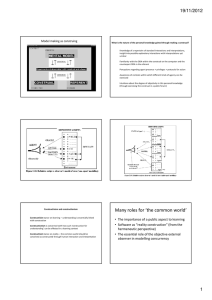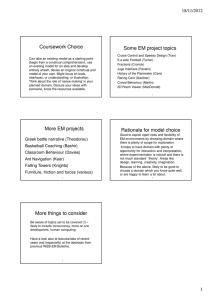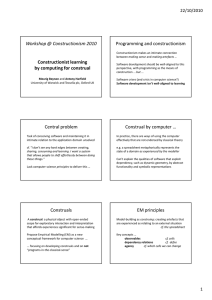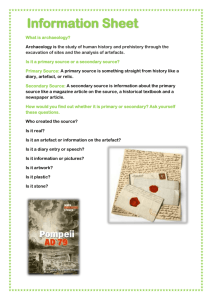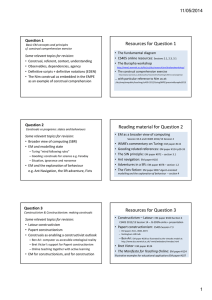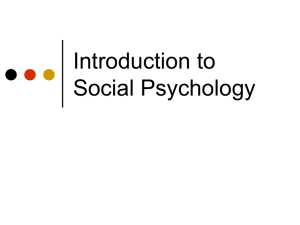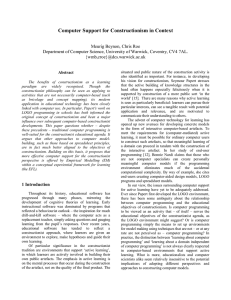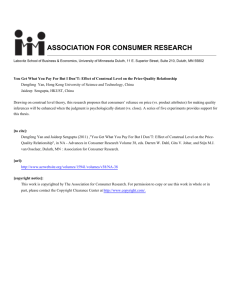What is Learning? Programmed Learning Human Learning Empirical Modelling and Learning
advertisement
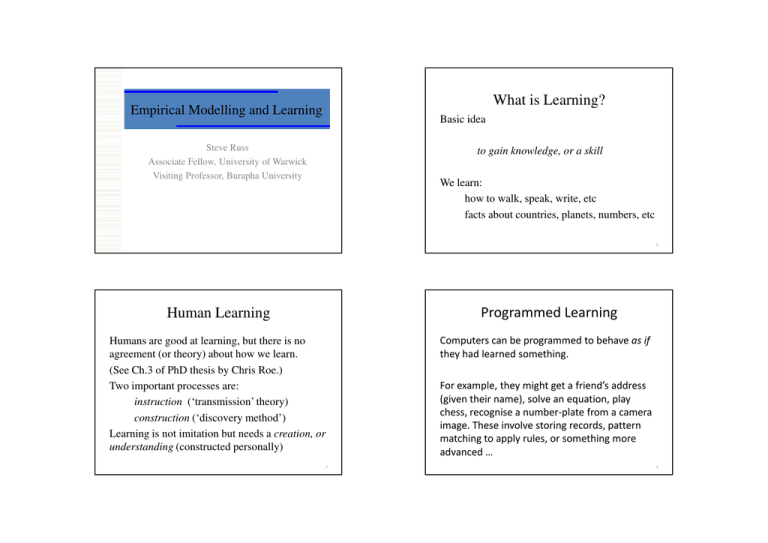
What is Learning? Empirical Modelling and Learning Basic idea Steve Russ Associate Fellow, University of Warwick Visiting Professor, Burapha University to gain knowledge, or a skill We learn: how to walk, speak, write, etc facts about countries, planets, numbers, etc 2 Programmed Learning Human Learning Humans are good at learning, but there is no agreement (or theory) about how we learn. (See Ch.3 of PhD thesis by Chris Roe.) Two important processes are: instruction (‘transmission’ theory) construction (‘discovery method’) Learning is not imitation but needs a creation, or understanding (constructed personally) 3 Computers can be programmed to behave as if they had learned something. For example, they might get a friend’s address (given their name), solve an equation, play chess, recognise a number-plate from a camera image. These involve storing records, pattern matching to apply rules, or something more advanced … 4 Machine Learning Instruction and Construction This is a branch of artificial intelligence that typically works with very large data sets seeking ways of finding patterns and significance. It focuses on prediction, based on known properties. An allied field is Data Mining which focuses on the discovery of (previously) unknown properties of the data. Artificial neural networks are a major approach to machine learning. How is machine learning related to human learning? (I do not know.) Instruction can be given by a book, a person, a computer, the Web etc. It can be ignored by the learner, or attended to passively. (No learning) Construction is needed within the learner to turn instruction received into personal knowledge. Constructionism is the thesis that construction inside the mind (learning) is made easier by some construction outside the mind (artefact/construal). 5 6 Computing for Lifelong learning Construction through construal Programmed learning, or e-learning, suits instruction and works best when there are prescribed learning paths. Adapting to students with varied experience (‘modelling the student’) is very hard. Lifelong learners need fewer constraints, and bring greater variety, than other learners. They especially need support from alternative approaches – including support for construction. A construal is something central to EM, it is an artefact (a thing made). As such it is well-suited to giving support to construction in learning. The entire approach to computing in EM is better-matched to the needs of the learner for flexibility, opportunism, blending of models, and the continuous evolution of both context and knowledge. The example of the clock construal. 7 8 New conception of computing technology Modelling with Dependency (1) Conceptual framework for classical computing – that of achieving functional efficiency through abstraction and decomposition – is ill-suited to the needs of learning. Learning involves blending new experience, and concepts, into a unique personal body of experience. ‘Making it your own’, understanding, involves a kind of internal, personal, construction quite unlike anything mechanical, or given by rules. Dependency ensures meaning of model directly understood by human (cf spreadsheet) Key idea of EM methodology: construction driven not simply by ‘function’ but by full domain understanding in terms of ODA Not the same as just ‘adding’ dependency to programming. Soundness of the method rests on the claim that construals are a good way to express understanding of domain interaction. 9 10 Modelling with Dependency (2) Empirical Modelling as Construction Emphasis is on the situation as experienced by the modeller – rather than a ‘target’ behaviour. Semantics is rooted in direct correspondence of experiences. E.g. spreadsheet without any names/labels – could recover semantics by experiment to find the patterns of change. (Cf the scientist - who has no ‘labels’!) Supports subjective understanding and prearticulate knowledge. 11 12 Important implication Developing educational software Educational software is conceived by teacher, implemented by developer, used by learner – in quite different contexts. Such separation based on distinction of formal computing and informal activities to do with meaning. In EM, supporting a constructionist approach, each role is adopted in same environment and with same methods of ODA framework. The roles are blended, student can become teacher, both can be developers. uses Student Teacher implements specifies Developer 13 14 Developing educational software Developing educational software uses uses Software use Student Teacher implements Student specifies Reality-centred activity Teacher implements specifies Software development Mind-centred activity Developer Developer 15 16 Empirical Modelling (EM) Perspectives of educational software • Offers a set of principles for model building in any of the student, teacher and developer roles: • Student vs teacher vs developer • Mind-centred vs reality-centred Teacher Student • Software development vs software use model How can we bring together these different perspectives? Why? interacts Developer 17 Support for Constructionism 18 Artefacts for active learning ‘Active learning’ is learning in a constructionist fashion - it involves the building of public artefacts. The mental processes during building are more important than any final product. Seymour Papert pioneered constructionist learning with the LOGO programming environment. But there is major difference between an artefact developed in active learning, and a computer program. Artefact is a source of experience. Learners’ questions: “What can I do with this now?” “How can I interpret this particular interaction?” Some interactions are familiar (artefact embodies knowledge), many remain unexplored (embodies ignorance). 19 20 Status of computer program Construal in EM Understanding of a program is in terms of: “This is what the program is intended for.” “These are the kinds of interaction you can have.” “These are the ways this interaction should be interpreted.” Inappropriate to regard a learning artefact as a program, instead we propose the notion of construal as developed in Empirical Modelling. Construal is something more primitive than program – possibilities for interaction and interpretation depend on the experiences offered and how they relate to a referent. Developing a construal is ‘voyage of discovery’. Quite unlike a conventional program capturing intended behaviours. Beam detector example. Significance of construal understood in relation to the Experiential Framework for Learning. 21 Experiential Framework for Learning 22 Papers summarised in slides private experience / empirical / concrete Re-thinking Lifelong Learning: Slides 7 - 8 EM paper #089 (2006) Computing technology for learning – in need of a radical new conception: Slides 9 - 18 EM paper #096 (2007) Computer Support for Constructionism in Context: Slides 19 – 22 EM paper #080 (2004) interaction with artefacts: identification of persistent features and contexts practical knowledge: correlations between artefacts, acquisition of skills identification of dependencies and postulation of independent agency identification of generic patterns of interaction and stimulus-response mechanisms non-verbal communication through interaction in a common environment directly situated uses of language identification of common experience and objective knowledge symbolic representations and formal languages: public conventions for interpretation public knowledge / theoretical / formal 23 24
